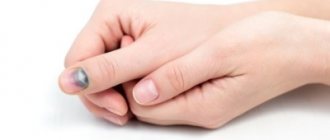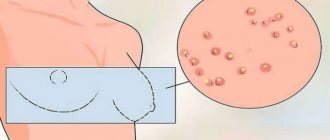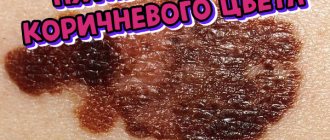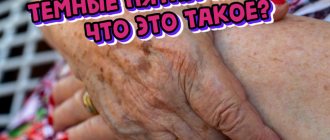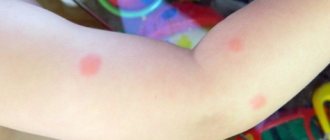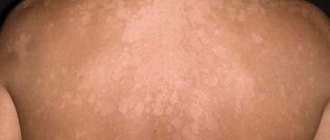White spots on the face are a common skin pathology among adults and children of all ages. The unaesthetic appearance of stains brings a lot of inconvenience and provokes psychological discomfort. Such skin defects should not be ignored, as they can be symptoms of dangerous diseases. In this article we will look at the reasons why they appear and how to treat them.
What are and features of white spots on the face
Melanin is responsible for skin color, hair and eye color in humans, and fur in animals. If light spots on the face or body are present from birth and there have been cases in the family of children born with depigmented skin, then albinism can be assumed. Otherwise, the appearance of a white spot on the face or body, arm or leg is a sign of illness and requires treatment.
The reasons for the appearance of areas of depigmentation are varied. Each has its own character of origin and flow. With a benign nature, the formations are distinguished by the following characteristic features:
- They don't tan in the sun. Tanning only emphasizes them. These areas of the skin suffer from ultraviolet irradiation. On the skin it will look like this - areas of normal pigmentation will be brown and tanned, and depigmented areas will be red and burned.
- They do not cause physical discomfort to the owner, they remain only a cosmetic defect - they do not itch, do not hurt, do not bleed.
Associated symptoms
White spots on the face can appear as a single formation or many small spots, which, as they progress, sometimes merge into one large spot. Such neoplasms are present on the skin for a long time and do not go away even for several weeks. In some cases, itching occurs before the manifestation of such pathology. In addition, the skin on the affected areas may peel off and become covered with a red mesh.
Sometimes a combination of symptoms indicates the development of dangerous diseases. Therefore, you should immediately consult a doctor if the white spot has the following symptoms :
- itches;
- itches;
- increases in size;
- covered with a red capillary mesh.
If nothing bothers you, but the spot does not go away for a long time, contact a dermatologist to diagnose and determine the exact cause.
Causes
The reasons for the appearance of white spots are difficult to find out. A dermatologist cannot always determine the cause of the appearance.
Factors influencing the development of depigmentation:
- the habit of sunbathing during the period of active sun - from 12 to 16 hours or excessive love for the solarium;
- decrease in the body's defenses;
- deficiency of vitamins and nutrients in general;
- pathologies of the gastrointestinal tract, endocrine system;
- stress factors;
- hormonal changes, including pregnancy;
- genetic predisposition.
Even if there have been cases of birth of albinos or vitiligo in the family, self-diagnosis is inappropriate. A harmless light area may hide a serious illness.
In children, the appearance of areas of depigmentation may be a consequence of severe pathology of infectious origin. Most often, a similar picture is observed in infants or children of the first year of life.
Additional factors that contribute to the loss of melanin in the skin in children are the introduction of complementary foods, helminthic infestations, and the body’s reaction to the vaccine.
Causes
Such a pigment spot is acquired during life and is practically never found in newborns. Too much pigment is synthesized in a small area of the skin and the underlying dermis, and it is quite difficult to influence this process. The final and exact causes have not been established; metabolic disorders and endocrine system failures are considered the “culprits”. In women, pigment spots form many times more often than in men. This is associated with fluctuations in the level of female hormones during the menstrual cycle and especially pregnancy. The following factors are known to provoke the formation of chloasma:
- pregnancy, menopause;
- inflammatory diseases of the female genital organs;
- chronic liver diseases, especially viral hepatitis and cirrhosis;
- long-term use of tablet contraceptives;
- excessive exposure to open sun;
- passion for artificial tanning, especially in outdated solariums;
- chronic infections, primarily tuberculosis.
It is still unknown exactly why the pigment is produced in a limited area, and not on the entire surface of the skin. It has been noticed that the pigment content sometimes decreases after childbirth. Persistent spots are formed due to chronic inflammation of the ovaries and long-term impairment of their function. It is almost impossible to predict how the body will react to a particular metabolic disorder.
Main types
There is no specialized classification. The basis for recognizing a particular white spot is a disease that causes melanin loss.
Types of stains:
- Pityriasis versicolor is a fungal disease. Spores and waste products of the fungus infect cells involved in melanin production. The color range of the spots can vary from light to pink and brown. There is no favorite location; they can be located on the body, face, or limbs.
- Psoriasis – white plaques. They peel and may itch.
- Setton's nevus is a white spot surrounding the mole. It is a harbinger of vitiligo and develops in solarium and beach lovers.
- Idiopathic guttate hypomelanosis - the causes are unknown, goes away on its own.
- Vitiligo – the causes of loss of pigment areas are unknown. White spots are located on the face and skin of the extremities. They cannot be treated.
- Scar changes - the most common reason for the appearance of such scars is incorrect treatment of acne, violation of hygiene rules when cleaning the skin. Small scars go away on their own over time.
- Melanoma - a characteristic sign is pain, rapid growth, the appearance of a vascular network over a lighter area.
How to get rid
For confirmed fungal infection, the use of topical antimycotics is indicated. Psoriasis requires the use of hormonal drugs and ointments. Oncological diseases – surgical removal of the tumor, chemotherapy or radiotherapy. It would be useful to take vitamin complexes.
Home methods
At home, it is recommended to use whitening masks with lemon juice, fermented milk products, strawberries and cucumbers.
Masks made from natural products should be applied for 15 minutes. The bleach is then washed off with warm water.
Cosmetology procedures
Modern aesthetic medicine will help remove areas of depigmentation on the face. In some cases, it is enough to clean the skin with various peels - acid, laser. This treatment will require time and patience. The standard course ranges from 3 to 10 procedures.
In difficult cases, the spot or scar will have to be removed or a piece of healthy skin transplanted.
Prevention of occurrence
Recommendations for the prevention of pigment loss in the layers of the skin come down to advice on proper nutrition, taking vitamin complexes, and proper cleansing of the skin.
Avoid exposing your skin to high doses of ultraviolet radiation. Do not get carried away with the solarium and sunbathe either early in the morning or in the evening.
If any suspicious areas appear on your skin, get examined by a dermatologist. Without identifying the cause of the disease and quality treatment, it is impossible to get rid of white spots.
But be prepared for the fact that even with the correct diagnosis, some pathological processes associated with pigment loss will remain with you.
The face in some cases becomes covered with white spots. They make a person's appearance repulsive and can be symptoms of serious diseases. You need to know what causes white spots on the skin of the face and how to deal with them using folk remedies, ointments and other cosmetics.
White spots reduce the patient's attractiveness
White spots on the skin
White spots on the face can occur for various reasons, both internal and external. Melanin does not form at the site of these marks on the skin. Most often, they become visible in the summer, after sunbathing, when healthy skin becomes darker. White spots usually do not have clearly defined boundaries and form on different parts of the face and body (near the eyes, nose, chin). Under their influence, the skin begins to peel off, change color, and become pink and red.
They are formed both in adult men and women, and in little girls and boys. The reasons for their appearance in a child are most often natural. Most often, the reasons for their formation in adult patients are:
- vitiligo;
- pityriasis alba;
- pityriasis versicolor;
- melanoma;
- pigmentless virus;
- scars and cicatrices.
White stripes on the skin of the face
1. Rectum. On the face it is represented by a projection zone on the surface of the skin of the upper left forehead. Functional impairment can manifest itself as skin pigmentation, acne, redness, and the growth of moles.
2. Sigmoid colon. Its representation is located on the surface of the skin of the left upper lateral area of the forehead. Functional impairment can manifest itself as skin pigmentation, pimples, redness, and moles.
3. Liver. The representation is located between the eyebrows, in the space between the base of the bridge of the nose and the line connecting the brow ridges on the skin of the forehead. Liver pathology is accompanied by skin irritation, acne, pigmentation, and moles.
4. Small intestine. Its projection is located in the middle part of the forehead, and with intestinal pathology it is manifested by skin disorders (pigments, pimples, redness).
5. Descending part of the colon. Its representation is located on the left lateral surface of the skin of the forehead. Functional disorders manifest themselves on the skin (pigmentation, dryness of the area, increased porosity, acne).
6. Left adrenal gland. The projection is located in the medial superciliary region of the left half of the face. With a functional disorder of the adrenal gland, pain in the periosteum of the superciliary region appears, and the skin reacts with irritation.
7. Area of the left kidney pelvis. It is projected onto the skin of the inner surface of the corner of the left eye and the tear duct. The pathological process in the area of the renal pelvis is sometimes expressed by a skin reaction in this area (darkening, pigmentation, redness, enlarged pores, growth of papillomas, wen). Sometimes the problem contributes to the formation of a blockage of the tear duct, an inflammatory process in it, and excessive lacrimation.
8. Upper pole of the left kidney. It is projected onto the brow ridge and the skin of the upper part of the eyelid. The disorder is manifested by a vascular pattern (swelling), pimples, redness, and porosity on the skin.
9. Left lobe of the liver. Projected onto the white membrane of the eye. A disorder in the liver is manifested by a red vascular pattern on the white of the eye.
10. Body of the gallbladder, spleen. The projection is located on the skin and on the periosteum of the temporal bone on the left side of the face. With bladder pathology, redness, pimples, pigment spots appear on the skin, its porosity and venous pattern increase. The periosteum of the temporal bone also reacts; it becomes painful upon palpation.
The fight against white spots
There are a number of cosmetic products that can treat these spots and restore the original appearance of the skin. Common products are whitening masks and cosmetic peels, which are based on lactic or citric acid. However, most beauty salon clients prefer to resort to the following procedures:
- Photochemotherapy. The procedure involves exposure to light rays, due to which the number of melanocytes begins to increase. This causes the destruction of melanin present in the skin and accelerated synthesis of a new substance. The affected area is completely filled with the required pigment after an average of 10 sessions of the cosmetic procedure.
- Plasmolifting. This procedure involves the injection of the patient’s plasma into the damaged parts of the skin. This helps to increase the concentration of platelets in the affected area. They have a positive effect on the restoration processes of stem cells. At the same time, melanin synthesis increases and the normal functioning of melanocytes is restored.
- Laser treatment. During this procedure, depigmented parts of the skin are treated using a powerful laser beam. Under its influence, the activity of T-lymphocytes, which have a destructive effect on melanin and reduce its content in the skin, decreases.
- Bleaching. This process stops the contrast between healthy skin and depigmented areas of skin. Monobenzone is used during this procedure.
- Skin grafting. This is an exceptional measure that is used in extreme cases when less radical methods do not help. It is a surgical intervention during which the damaged area of the skin is filled with microscopic areas of healthy skin.
Further care
The skin needs competent and proper care. The lack of such care often causes the formation of white spots. It is necessary to wash your face regularly with soap, do not touch your skin with dirty hands, and do not use cheap skin care products.
Patients with a tendency to develop white spots need to eat properly. You should avoid consuming the following foods:
Additional Information. If it is impossible to refuse this food, it is necessary to reduce the amount of these foods consumed.
The diet must be enriched with vegetables and fruits. Food should be cooked more by steaming or in the oven. If white spots on the face begin to appear suddenly and in excess, this is a reason to consult a gastroenterologist. In some cases, white marks are symptoms of disorders in the functioning of the liver and diseases of the gastrointestinal tract.
Causes and symptoms
The reasons for the appearance of pigmentation on the face can be either viral diseases, when the infection is treated with medications, or severe stress and a banal malfunction in the body.
Answer to the question: Why do white spots appear on the face? There will be the following factors:
- excessive tanning;
- weak immunity;
- vitamin deficiency, lack of vitamins and microelements;
- disruption of the gastrointestinal tract, liver disease;
- hormonal imbalances, in particular during adolescence and pregnancy;
- nervous tension and depression;
- heredity;
- ignoring the rules of personal hygiene, using other people's hygiene items.
The appearance of uneven color on the skin can be caused by a lack of melanin. In some people it is congenital, in others it develops with age under the influence of certain factors.
In many cases, with such pigmentation on the face, the skin is affected by a fungus that disrupts the normal production of melanin. The spots are snow-white or brownish.
If the cause is a contagious fungus, then without appropriate treatment the disease will progress more strongly throughout the body, and not just the face. The fungus can also cause red and white spots on the face, which will also gradually spread to the rest of the body.
If the spots that appear do not tan in the sun, peel and itch, then these symptoms correspond to lichen versicolor. An example of such a skin defect is shown in the photo.
Other Causes of White Spots
- Also, severe peeling of the epidermis is a symptom of psoriasis. With such a defect, the affected areas will be dry, rough, and scales will peel off greatly from the epidermis. Both diseases are infectious and require mandatory drug treatment.
The appearance of uneven color on the skin can be caused by a lack of melanin.
- If a white spot has formed around the mole, then most likely it is Setton's nevus. The mole in the center in such a situation rises slightly above the skin and is located clearly in the center of the colorless circle. Several such nevi may appear on the face at once due to excessive exposure to the sun.
- In some cases, after Setton's nevus, a person may develop vitiligo. This disease can occur in teenagers and young adults under 30 years of age. This is a rare disease and the causes of its occurrence have not been fully studied, but the main ones include ultraviolet radiation, nervous strain or hormonal imbalance. What vitiligo looks like is shown in the photo below.
- Small white spots and dots on the face sometimes occur after excessive tanning, especially when the skin has been sunburned. When exposed to sunlight, the body produces less melanin; such pigment spots are not treated and sometimes go away on their own after a while.
- In addition, white spots on the face of a man or woman can form after improper removal of acne at home or after skin injuries. Most often, such scars disappear after gradual renewal of the epidermis.
- Any person who has cosmetic defects on their face needs to keep in mind that this may be a symptom of a serious illness, including oncology. Therefore, to exclude such diagnoses, you should immediately visit a doctor.
- A child may develop a similar defect on the skin due to hypomelanosis. Sometimes it develops after severe viral illnesses, but in most cases, hypomelanosis occurs in a newborn. Also, if a baby is born with a white spot, it may be a congenital nevus of Ito or an anemic nevus.
- In children over three years old, light spots sometimes appear from worms, after sunbathing and some vaccinations. The cause can also be a fungus, in which case the spots will not just be white, but will be accompanied by itching and peeling.
Preventive measures
In order to prevent the appearance of light spots on the face, you must follow certain recommendations:
- do not stay in direct sunlight for too long;
- use decorative cosmetics to protect against ultraviolet rays;
- follow a healthy lifestyle, eat a balanced and healthy diet.
Note! It is necessary, if possible, not to go outside on hot days from 11.00 to 16.00 and use a protective cream in the heat.
Prevention can prevent the development of white spots
It is possible to defeat white pigment spots on the face with the help of special cosmetics. Correct use of these drugs allows you to get rid of them and achieve good results in a short time.
Diagnostics
In many cases, diagnosis is not difficult. The typical location of the spots, their appearance and characteristics leave no doubt about the diagnosis. Chloasma is also supported by the fact that at birth there were no spots or inflammations on the skin.
To confirm the diagnosis, two auxiliary methods are used: dermatoscopy and siascopy. Dermatoscopy is an examination using a special device under high magnification in good lighting. The procedure is completely safe and painless. First, gel or oil is applied to the stain so that light can penetrate through the stratum corneum. The turned on dermatoscope performs fluorescent illumination and multiple magnification, from 10 to 30 times, at which pictures are taken. Analysis of images provides answers to many questions.
Siascopy is a spectrophotometric instrumental study that allows you to find out the exact structure of pigment formation. The result is stored digitally for later comparison.
Clarifying the characteristics of a pigment spot is only part of the diagnosis. It is necessary to detect all changes that led to the formation of pigment. This is a complex task that requires careful examination.
It is recommended to perform the following steps and additional research:
- consultation with a gynecologist to assess hormonal status;
- Ultrasound of the pelvic organs and other organs according to indications;
- biochemical blood test with expanded liver complex;
- stool analysis for dysbacteriosis;
- coprogram (general stool analysis);
- Ultrasound of the abdominal organs;
- gastroscopy.
If diseases are detected during the examination, then consultation with specialized specialists and additional instrumental and laboratory diagnostic methods are necessary. But you need to start the examination with a visit to a dermatovenerologist.




